AI search—aka AEO (AI/Answer Engine Optimization) or GEO (Generative Engine)—is on everyone’s mind.
There’s a new user experience (i.e., AI platforms) taking the world by storm. And CEOs, execs, boards, and especially marketers all want to know how to make sense of it, how to measure it, how to refine our strategy, and how to reach users where they are.
Enter: AI search products.
At the time of this writing, dozens of vendors claim to offer some form of AI search functionality. Seeing as there was not much of a category at the beginning of 2025, it’s pretty clear that there’s a new market emerging, and fast.
And, while it’s great to be in a hot space, with the sheer volume of new vendors popping up weekly, it’s not so easy to parse what’s real from vaporware.
So, to help you quickly get to brass tacks and spare the opportunity cost of choosing a product that overpromises and underdelivers, we created this buyer’s guide for AI search products.
DISCLAIMER
Now, of course, with the Scrunch platform including an AI search component, we are clearly acting as a biased party here. While we’ve tried to put on our objective 3rd-party hats while writing this guide, the very nature of this content is biased (so take it with a grain of salt).
tl;dr
This is a long guide (3000+ words). It’s intended to be used more as a reference material vs. something to be read from top to bottom.
If you’re just here for the key takeaways to keep in mind when considering an AI search product, they can be summed up as: make sure it’s real, make sure the data is live, and make sure you can self-serve.
Here are four things you can ask/verify live on a demo call with a vendor:
1️⃣ Create a brand on the fly: provide a brand (yours, a competitor, a brand you love) and make sure setting up prompts can be done in the time of a 10-minute demo.
2️⃣ Create and monitor custom prompts: many vendors choose the prompts and categories for you. If you need the flexibility to create and monitor your own custom prompts (most do), be sure it can be done in a self-serve way.
3️⃣ Data config and extensibility: you’ll likely need to configure, drill down, and report on data in the way you need—e.g., find top citations in North America for bottom-of-funnel prompts. Not only that, verify that you can export and share reports as well. And if you need data via API, be sure to ask about that too.
4️⃣ Enterprise checkboxes: If you have enterprise-like requirements—SOC2 Type II, role-based access control (RBAC), API extensibility, multi-brand management, scale of prompts to track—be sure to ask and verify them up front.
README: How to use this guide
As mentioned in the disclaimer above, there’s a clear bias in this AI search buying guide.
That said, this guide aims to share the purchase patterns we’ve seen come up again and again before choosing a product for AI search. We’ve grouped features to make it easy to jump to the capabilities that matter most to you.
Use it as a reverse RFP. That is, cherry-pick the requirements that you care about from below and plug them into a score sheet to evaluate AI search products.
If you're just here for the RFP template, you're in luck: grab a copy of this guide modified in RFP format →
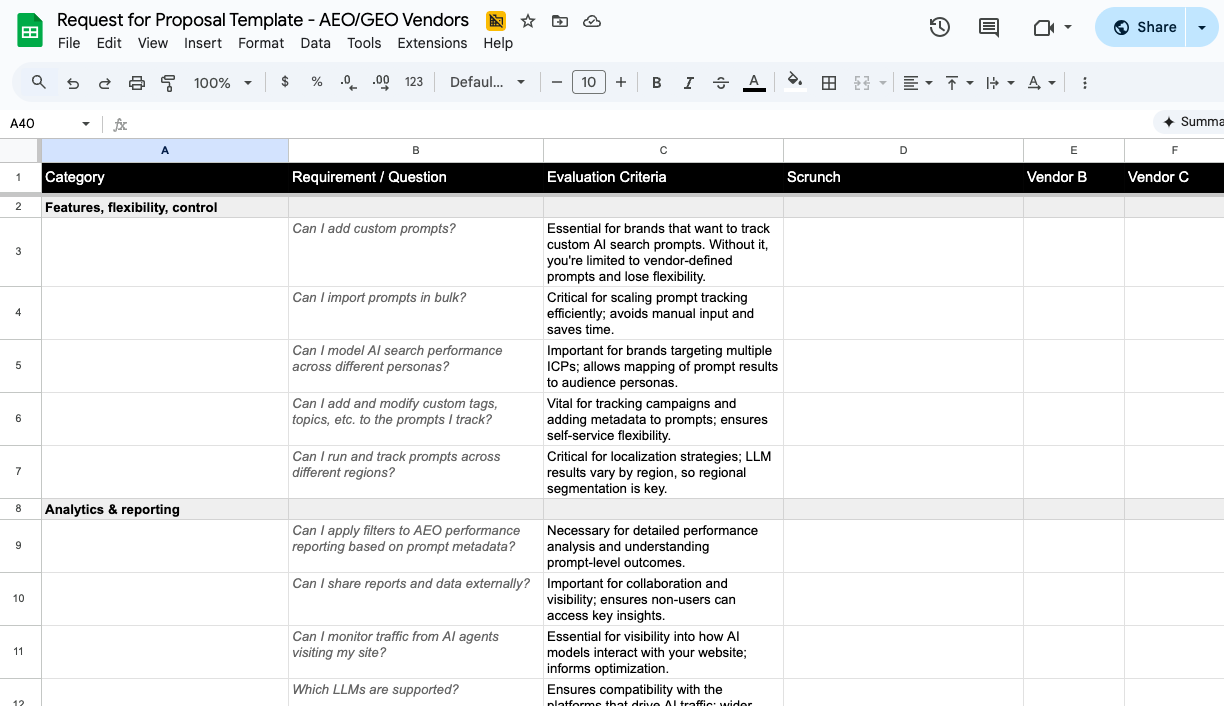
Again, don’t take our word for it (don’t take anyone’s word for it, for that matter). Once you have a good idea of your particular requirements, verify with vendors not just by asking them, but by actually seeing the product in action. Even better if you can try it out for yourself.
Features, flexibility, control
As you weigh options to track, inform, and grow on your AI search presence strategy, it’s wise to consider your preferences on the spectrum of hands-on control vs. full-fledged service required–e.g., can you make changes within the product yourself, or do you have to ask a customer success rep to do it for you?
Here’s a set of requirements to ask about product features, flexibility, and control:
Can I add custom prompts?
While this feels like a table-stakes feature, you’d be surprised at how many vendors don’t allow (or charge a premium for) tracking custom prompts—i.e., you can write, load, and track any prompt you want.
If including sets of your own custom prompts is a requirement, be sure to both ask this up front and confirm you can self-serve rather than asking support to add prompts for you on the backend.
How to add custom prompts with Scrunch:
From our Prompt view, there’s a big blue button to + New Prompt. When you click that, it opens up a modal to add any prompt you’d like.
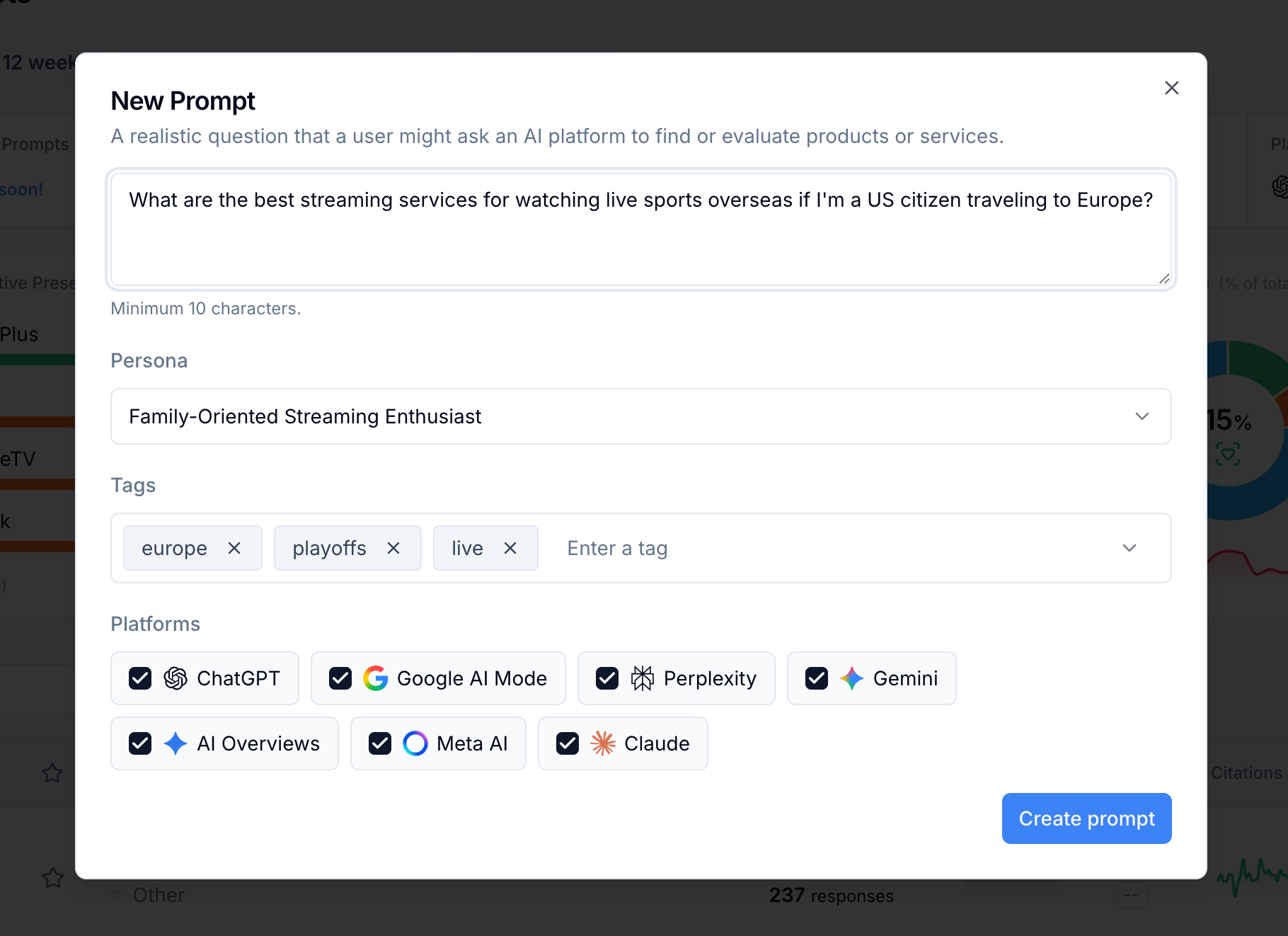
Can I import prompts in bulk?
Adding prompts one at a time gets quite tedious when you have a long list of custom prompts to track. So, if you’re planning to load many prompts at once, be sure you can do so via bulk addition features. That way, you can import many prompts at once from SEO keywords, CSV imports, copy/paste a list of prompts, etc.
How to bulk add prompts with Scrunch:
From our Prompt view, click the arrow of the + New Prompt button and select options to Bulk Add Prompts, Import Prompts from CSV, Convert SEO Keywords, or Generate Prompts with AI.
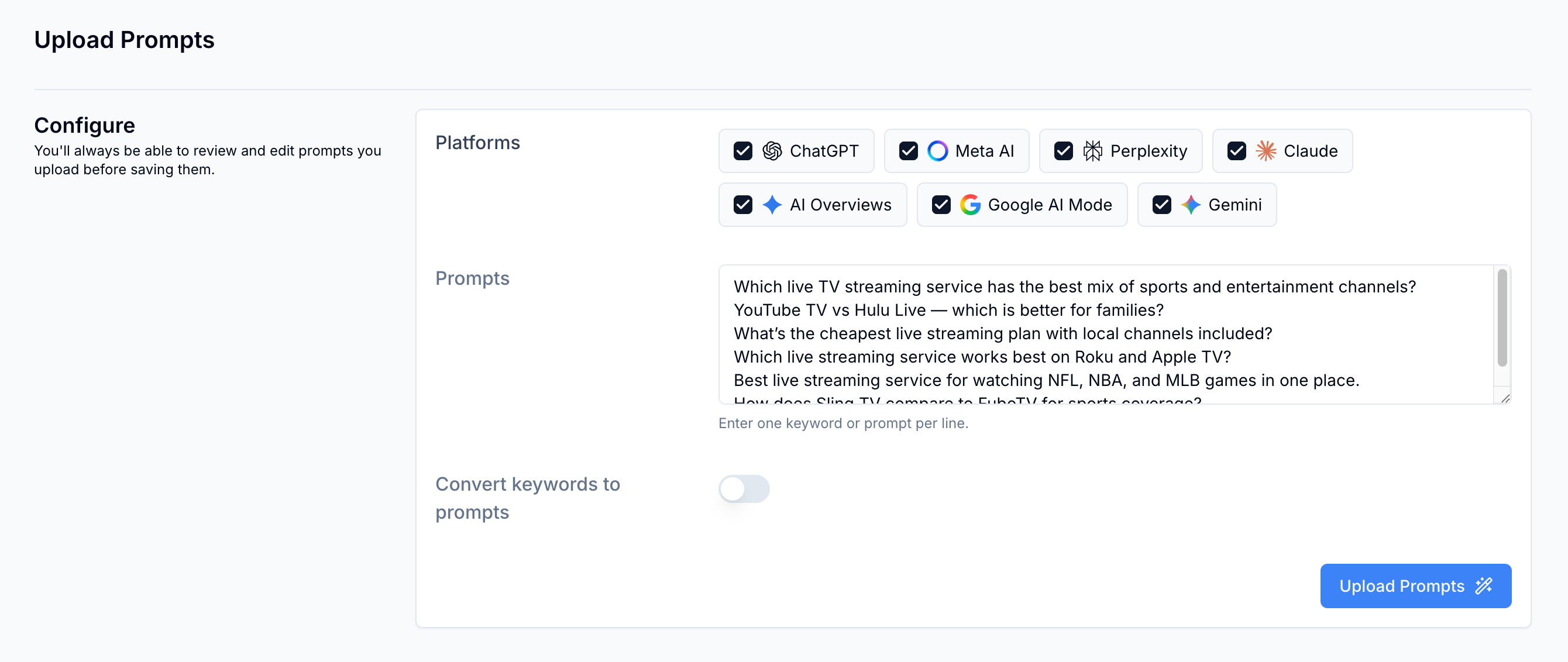
Can I model AI search performance across different personas?
If you have multiple ideal customer profiles—e.g., Marketing Mary, Sales Sally, Operations Oscar—you’ll probably want to model and match prompt performance to those prospective personas.
If this is a requirement, verify that 1) it’s possible, 2) it’s self-serve (if that’s crucial), and 3) that you can filter and report by persona.
How to track prompt performance by persona with Scrunch:
When setting up Scrunch, we’ll automatically generate personas for you with AI. From there, you can add and modify to your liking anytime. You can also filter reports, prompts, and citations by persona.

Can I add and modify custom tags, topics, etc. to the prompts I track?
A lot of AI search vendors do the choosing for you. That is, they infer the topics and prompts to track (or give you a limited set of options based on the data they purchase). Not only that, once set, modifying a topic requires asking support to make a change on the backend.
If you require the flexibility to modify or add topics (e.g., a neobank could add “tax-loss harvesting” as a new topic) or require the ability to add a custom tag to prompts (e.g., add a tag to track campaign performance “2025 product launch”), make sure it’s possible in the product you choose. And even better if you can edit tags and topics for prompts in bulk!
How to add custom tags, topics, and funnel stages with Scrunch:
Scrunch gives you complete control over how topics, tags, models, and stages are mapped to the prompts you’re tracking.

Can I run and track prompts across different regions?
LLM response results vary widely depending on the region of the person prompting. If localization is a factor for your brand, it’s essential to segment prompts by region and select a vendor that supports this.
How to track prompts across regions with Scrunch:
From the Context settings view, you can add new personas. For each persona, you can set the region. Once set, you’ll be able to select filters by region for reporting, prompt performance, and citations.
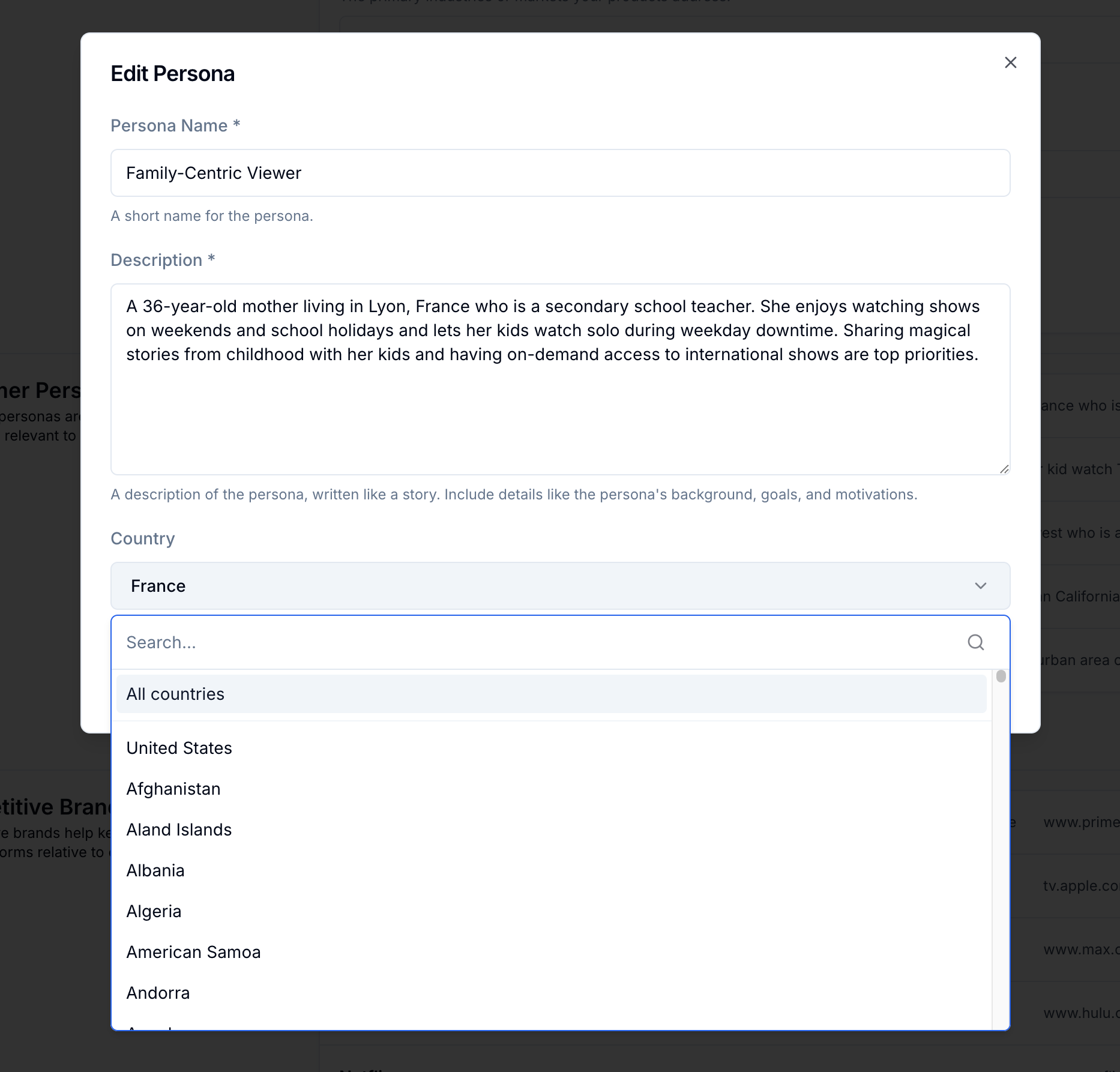
Analytics & reporting
Not only is it ideal to track prompts in the way that works to your liking, it’s also helpful to have the right level of visibility and access to performance metrics.
Here’s a set of analytics and reporting requirements to consider:
Can I apply filters to AI search performance reporting based on prompt metadata?
Having the flexibility to include context for the prompts you’re tracking—e.g., by topic, by persona, by funnel, etc.—is only useful if you can apply it to reporting. For example: Are you able to look at prompt performance by funnel stage? Can you further filter by model? Can you apply custom tags?
These are all questions you should be asking a vendor and verifying if you plan to go beyond surface-level performance reporting.
Drill down on any prompt metadata with Scrunch:
With Scrunch, any report, set of prompts, or citations can be filtered by mixing and matching dimensions, including: funnel stage, topic, region, persona, model, or custom tag.
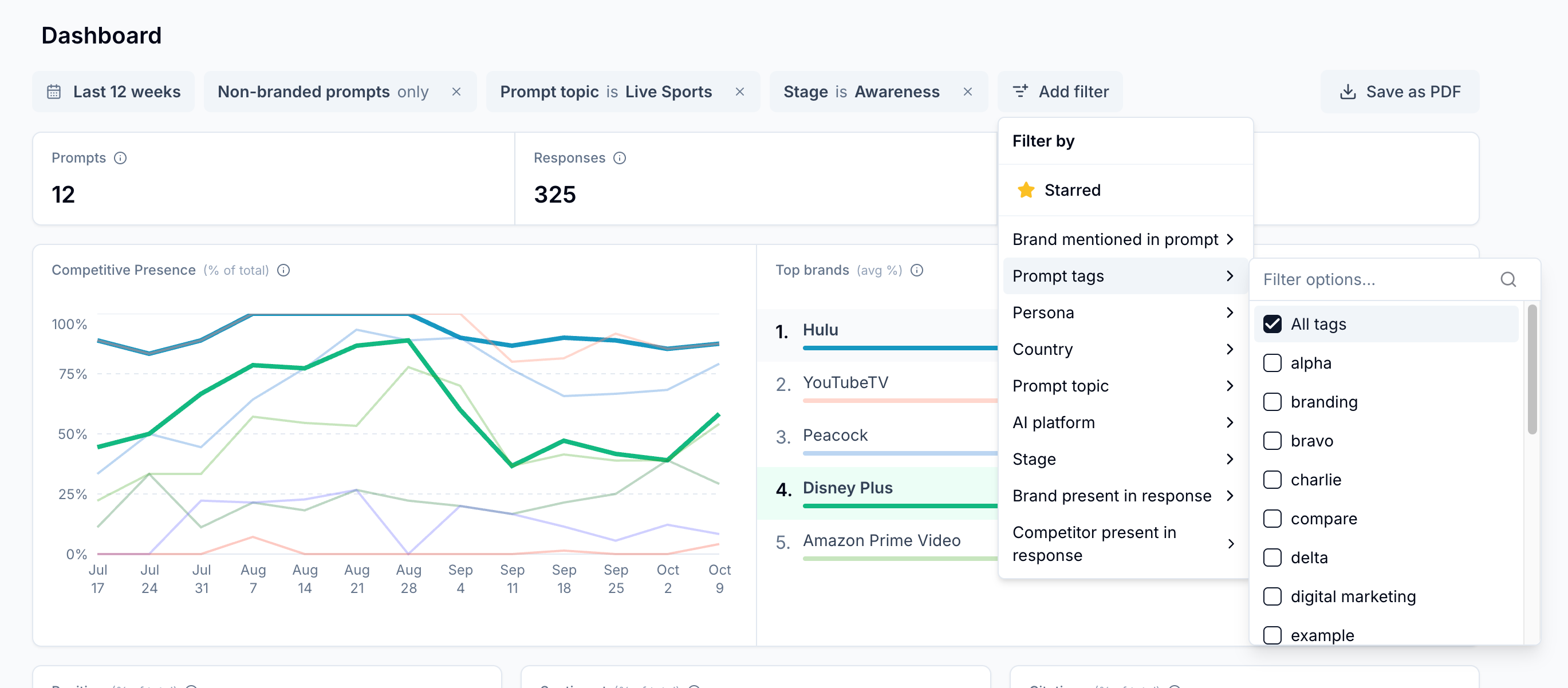
Can I share reports and data externally?
If others need to view performance metrics (and they always do), it’s helpful to either 1) share via a mechanism within the product or 2) integrate with data visualization systems of record like GA4 or Looker Data Studio, where others can access.
Even better if those integrations are templatized so you don’t have to build dashboards from scratch.
How to share AI search performance externally with Scrunch:
There are two ways to share performance outside of team members in the Scrunch workspace: 1) Save to PDF for distribution, and 2) native integrations with GA4 and Looker Studio—both of which come with a template to make performance tracking all the easier.
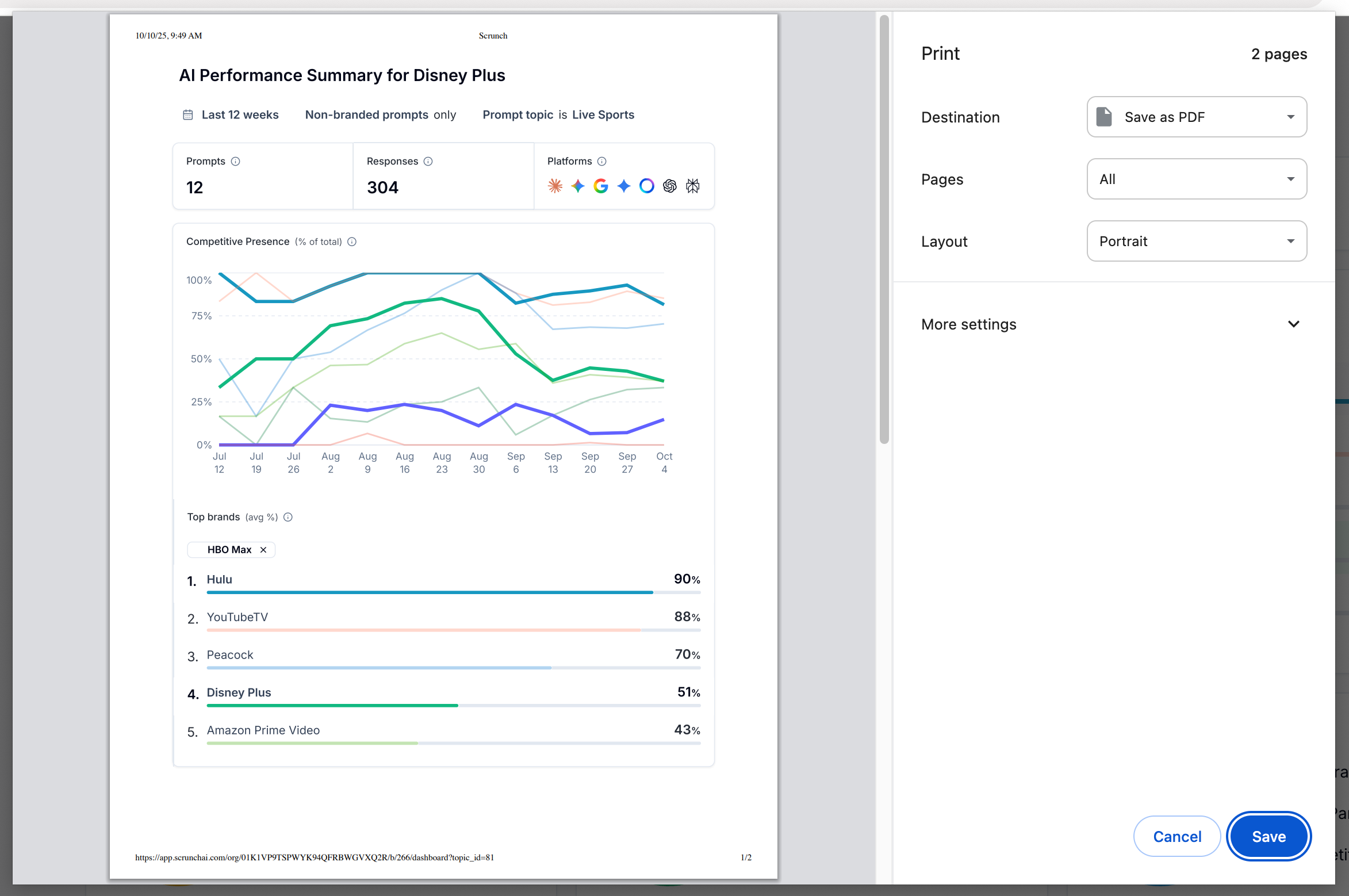
Can I monitor traffic from AI agents visiting my site?
In a world where AI agents are researching on behalf of your customers, it’s going to be more and more common to start measuring website traffic based on how often, what pages, what model, and what type of agents are crawling your site.
How Scrunch monitors AI agents visiting your site:
By connecting to your CDN or web service provider (we have integrations for Akamai, Cloudflare, Vercel, WordPress, and more coming soon), Scrunch will give you a real-time feed of agent traffic, including a breakdown by top pages, models, and more.
Which LLMs are supported?
While ChatGPT might have a large share of the market, there are still many other models, such as Perplexity, Claude, Gemini, and Google AI, that are widely used.
Not only that, results and citations vary widely across models. For that reason, it’s essential to use a product that offers support for the models you care to track. And, if you’re not sure, look to your bot referral traffic to see what models are currently driving traffic.
LLMs that Scrunch supports:
You can currently track performance for any prompt across ChatGPT, Claude, Meta AI, Perplexity, Gemini, Google AI Mode, and AI Overviews, with more coming soon.
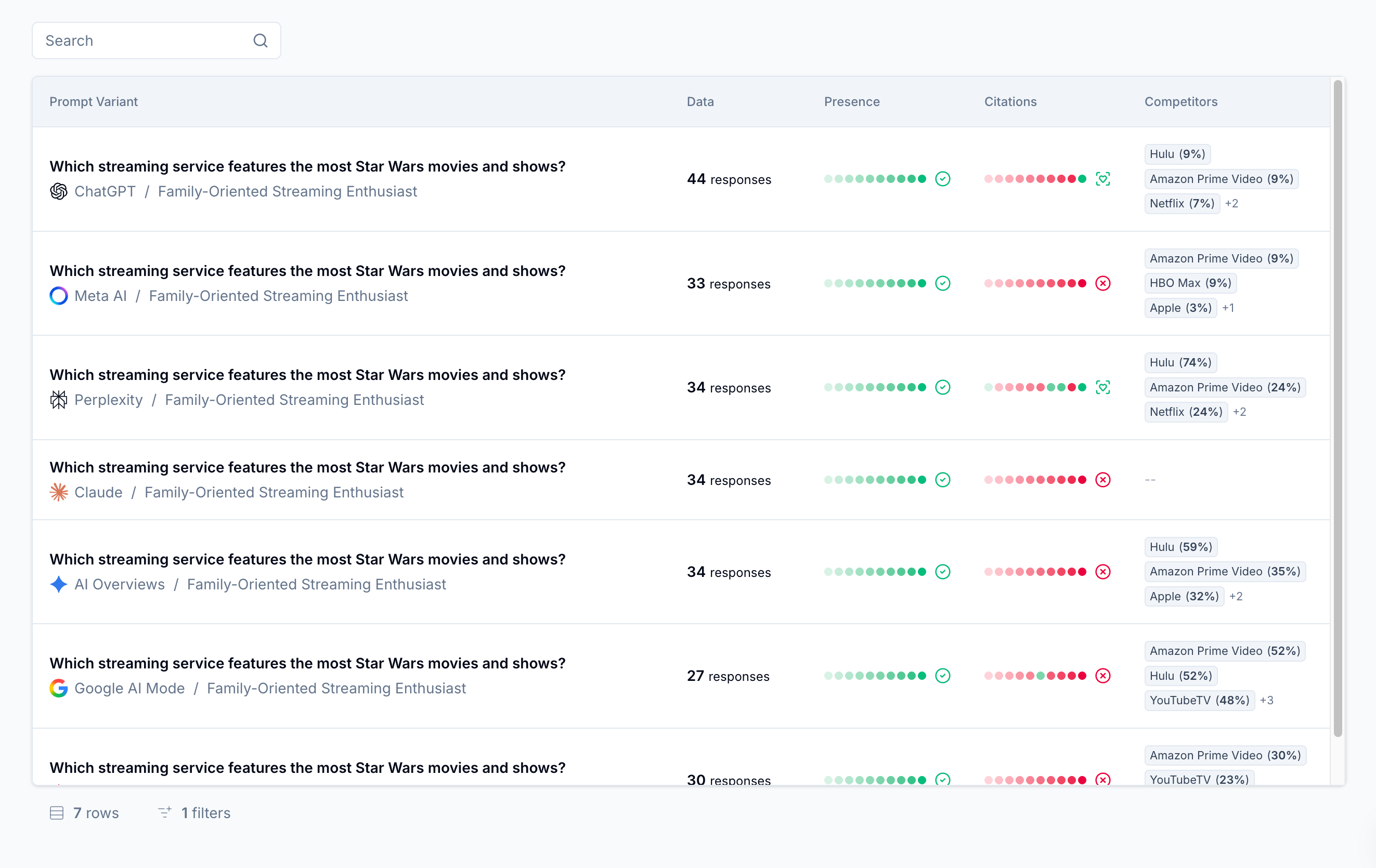
Insights & actionability
With prompt tracking and analytics in place, you can surface both strategic and technical insights to grow your brand presence.
On the strategic end, it could be uncovering insights that lead to content creation, optimization, or citation building. On the technical side, that could mean modifying pages to unblock AI traffic or formatting pages to make them easier for AI agents to parse.
AI search insights and actionability requirements to consider:
Can I audit the pages on my site to spot technical issues that are preventing them from being seen by LLM agents?
This is an obvious requirement: if your pages are blocking or preventing AI traffic from retrieving content (e.g., JavaScript is preventing content from being exposed), you’re going to have a hard time getting that content shown or cited by LLMs.
To uncover those technical mishaps, it’s helpful to have an AI search tool that can diagnose pages that are technically under-optimized or blocking AI agents from content retrieval.
How page audits work in Scrunch:
We have a page audit tool in Scrunch that detects common website issues that can prevent your page from being cited by AI search engines. Enter any URL and run it to uncover any issues with your pages.
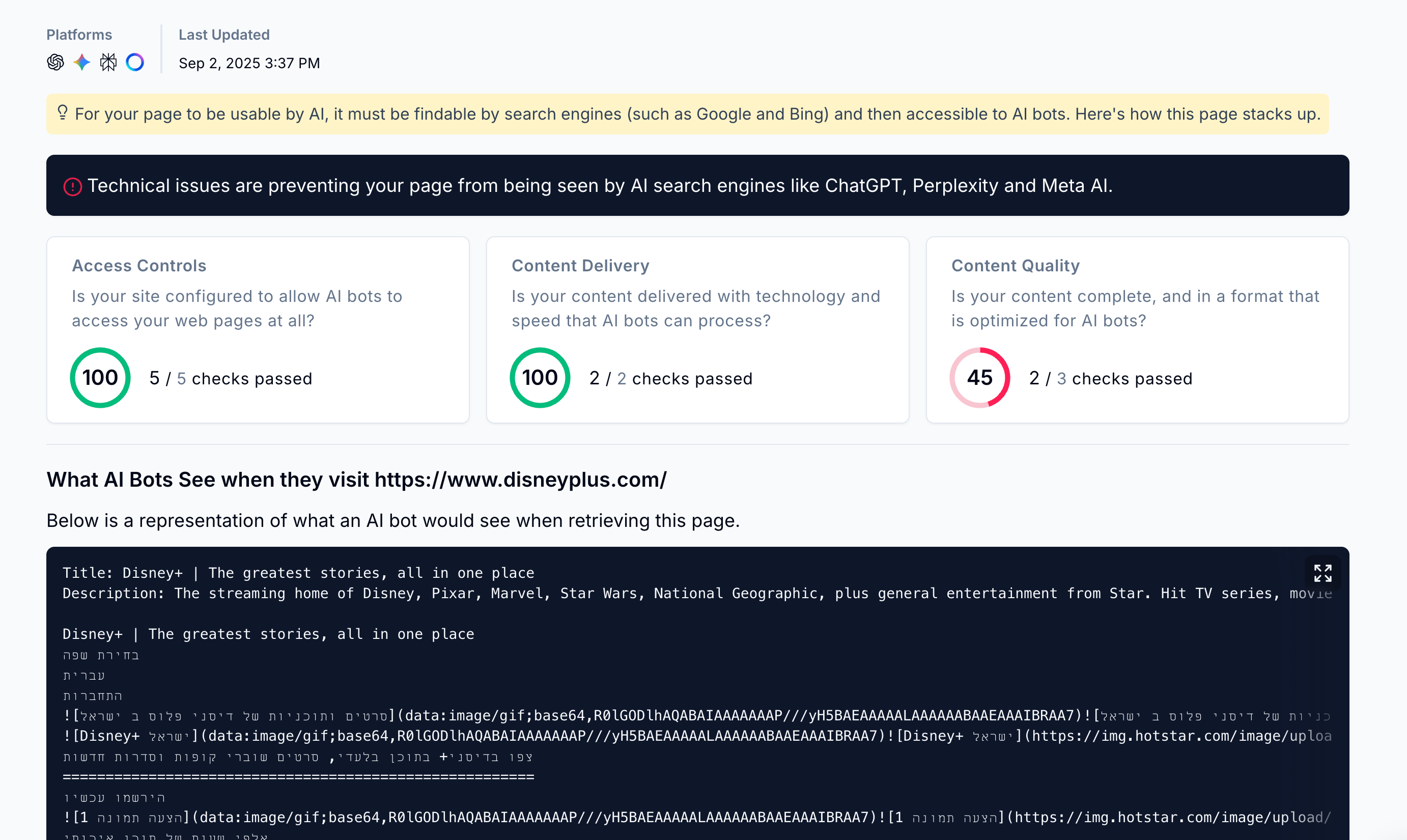
Can I uncover strategic insights that inform my AI search strategy?
This is a big topic with many factors that can influence it. To get to the bottom of your requirements, it’s helpful to get clear on the insights you’ll need across the following groupings:
Competitive: Can I aggregate responses mentioning competitors but not my brand?
Sentiment: Can I uncover prompt responses citing user-generated content that negatively reflects my brand?
Reach: Is my brand not showing in results because I don’t have content that addresses it, or because my content is not being found by retrieval or training bots?
By preemptively thinking through the questions that you’ll want to answer to inform your AI search strategy, you’ll be able to 1) vet that it’s possible with a vendor and/or 2) know if that vendor can work with you on a strategic level by problem-solving together.
How to uncover strategic insights to reach users on LLMs with Scrunch:
While we can’t really prove that we’ll be a strategic partner alongside your AI search journey (although we are for hundreds of customers), we have built insight discovery into the product.
Within the Insights view of Scrunch, you’ll see optimization opportunities from AI responses that mention competitors but not your brand, and content gaps like LLM searches for your key topics that aren't finding content matches on your website.
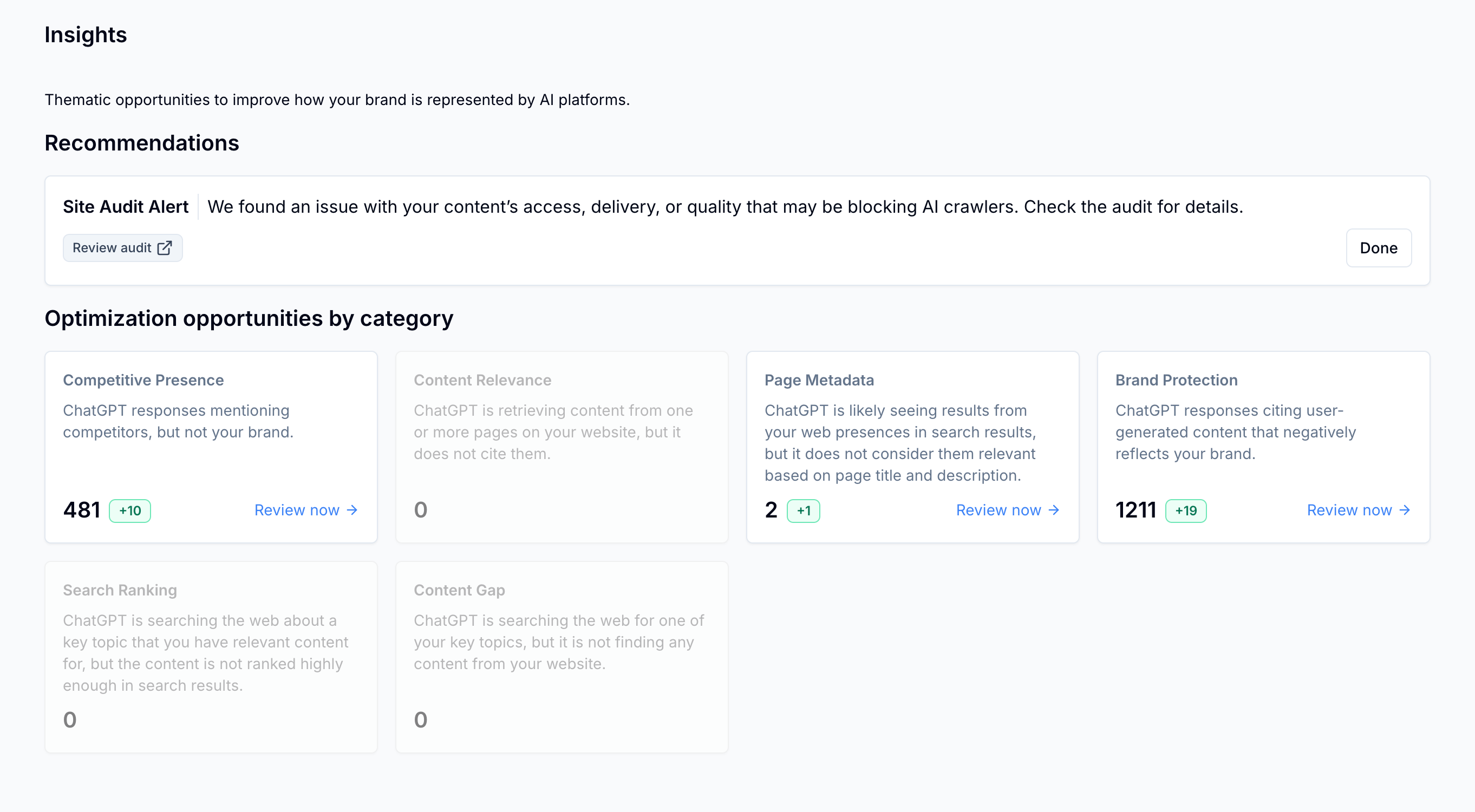
Can I uncover citations by dimensions like funnel stage, persona?
Not all prompts are created equal. And citations (i.e., the website sources that an LLM uses as reference material to inform a response) often vary widely.
The ability to not only see the citations that LLMs are rewarding, but also drill down by dimensions (e.g., model, funnel stage, persona, region, topic, tag, competitor inclusion) becomes a helpful factor for prioritizing a sound citation strategy.
How to inform your AI search citation strategy with Scrunch:
Scrunch not only shows you who’s being cited (you, your competitors, 3rd parties) and where, but also lets you drill down into any number of dimensions—from funnel stage to model—to reveal the citations associated with high-value traffic and conversions.
Enterprise: security, scale, integrations
For enterprise use, there are table-stakes requirements (SOC2 Type II compliance, SSO, role-based access control) and scale requirements (can this thing handle thousands to millions of prompts?).
While it’s a given that enterprise companies have a laundry list of requirements, here are some non-starters we see time and time again.
Is this vendor SOC2 Type II compliant?
Simple yes or no here. For many companies (not just the enterprise), this is a security requirement. You’d be surprised at how many AI search products lack SOC2 Type II certification, so be sure to check upfront whether it’s a requirement.
Scrunch is SOC2 Type II compliant:
Yes, we’ve got this. It’s also verifiable via our Trust Center →
Who can access the product? And at what level of access?
For both security and usability reasons, many teams require different levels of product access (e.g., admin, editor, viewer, guest, and billing). This is commonly known as RBAC (role-based access control).
If you have a team of more than one, you’ll likely need it.
How role-based access control and multi-user management work in Scrunch
Out of the box, Scrunch comes with options for three roles:
✅ Admin: full organization access and settings
✅ Editor: can add prompts, manage brand settings
✅ Viewer: read-only access to dashboards and reports
For multi-brand accounts, admins can manage members (and access) by brand.
Can I access AI search data via an API?
Many larger-scale companies just want the data. They’ve got the technical teams and systems of record in place (think data warehouse or analytics platform) to plug data into so that it can be accessed and used by data teams.
If this is you, make sure to check the API's availability and its documentation.
How the Scrunch API works:
We’ve built a thoughtful API to make it easy to integrate and extend your Scrunch data to the systems you need. For more, visit our AI search data API docs: https://intercom.help/scrunchai/en/articles/12143729-scrunch-ai-early-access-api-documentation
Agencies & multi-product brands
For teams who need to manage more than one brand (think an agency with many clients or a CPG with many product lines), it’s ideal to have a central workspace for managing said brands. Even better if you can spin up new brands in a self-serve way.
Requirements to consider:
Can I create a new brand to track on the fly?
If you’re managing multiple brands, you’ll likely need to spin up a workspace for a new brand that’s either a new product line (if you’re a multi-brand conglomerate) or a new client (if you’re an agency). And, if that’s the case, make sure it’s possible to self-serve by adding new brands to track.
How to manage multiple brands in Scrunch:
Adding a new brand can be done on the fly and takes just a few minutes to spin up a fully complete workspace, since we use AI to fill in the blanks for persona, competitors, topics, and prompts.
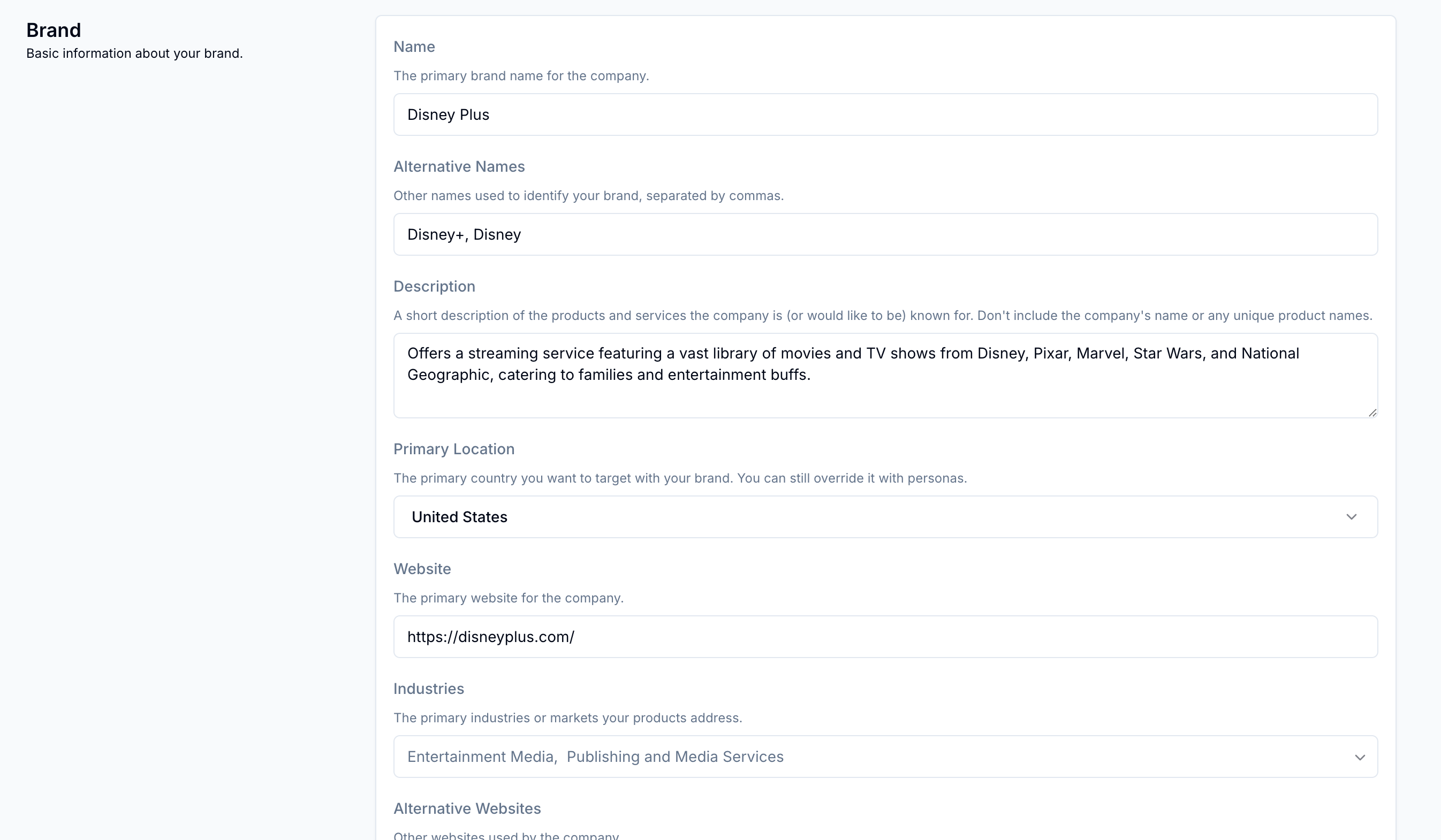
I’m an agency. Can I spin up a new brand for prospecting?
In addition to managing multiple brands from a single workspace, many agencies want the freedom to generate a proof of concept to show prospective customers. If that’s you, make sure you don’t have to ask an account rep every time it’s needed.
How agencies spin up new brands for prospecting purposes with Scrunch
Not only can agencies manage multiple brands with Scrunch, we also provision “prospecting” licenses to allow agencies to spin up new environments for client pitches—no support needed.

Can I manage multiple brands from a single workspace?
If you manage more than a couple of brands, it becomes very cumbersome to maintain workspaces for each, especially if you have to log in and out to switch between them (what was that password again?).
If that’s you, make sure to partner with a vendor who supports the ability to toggle from one account to another from a centralized workspace.
How to manage multiple brands in Scrunch
Agencies and larger conglomerates can manage multiple brands under a single account with Scrunch. All is managed and provisioned from an admin seat. Once created, those with access can seamlessly toggle between brands from a single account.
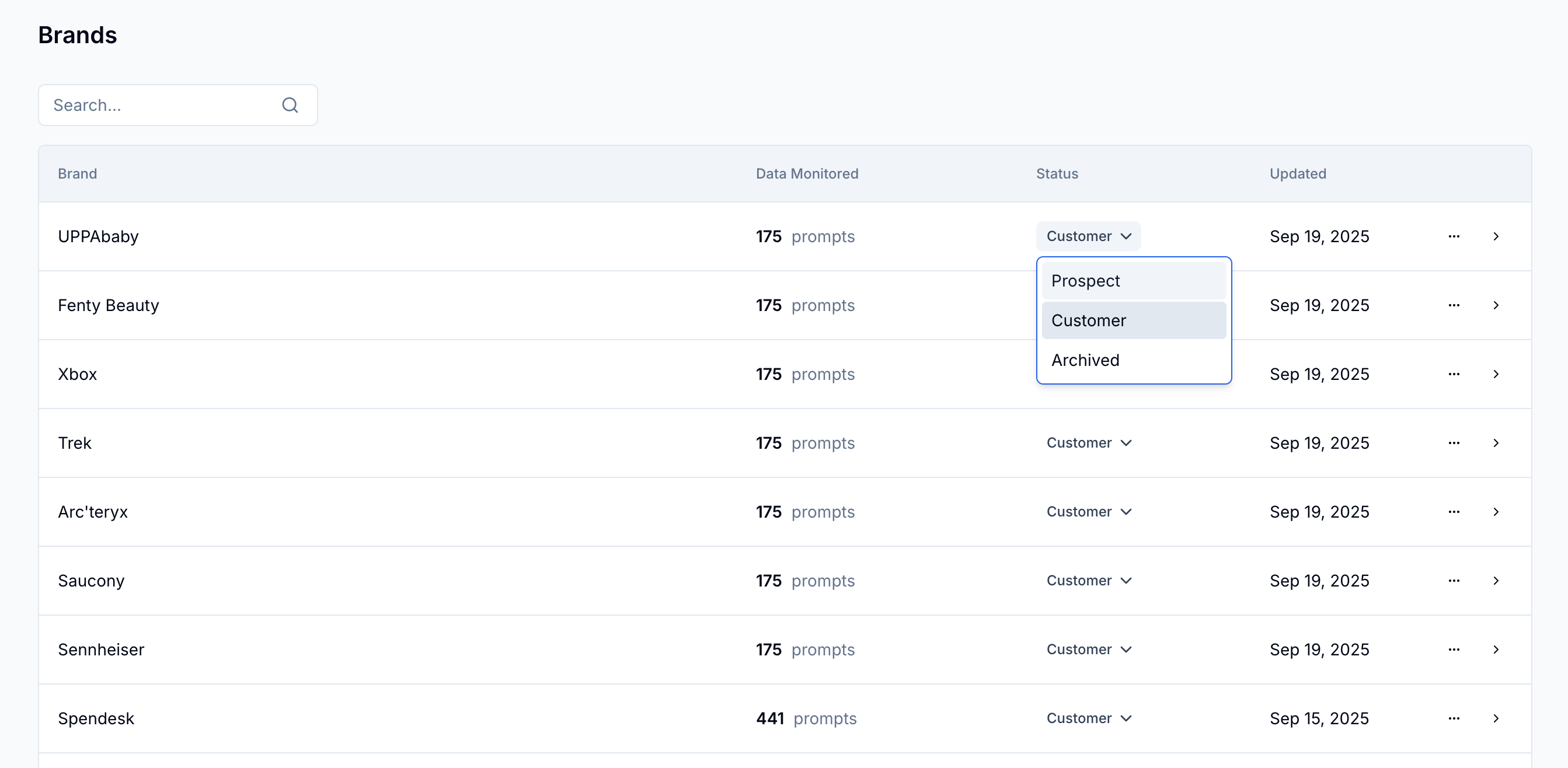
A (biased) RFP template for AEO/GEO vendor evaluation
As you evaluate options in your AI search vendor search, it can be handy to shop around your requirements via an RFP (request for proposal).
Because RFPs are a pain to create (also to fill out but that's not your problem), we went ahead and took the requirements from this guide and dropped them into a template you can download: RFP template for AEO/GEO →

One last thing... as you embark on your AI search journey, we'd love to chat. Find a time to talk see a demo, ask questions, and get access to Scrunch here →

